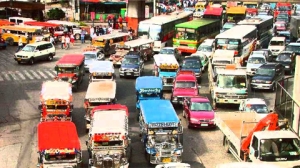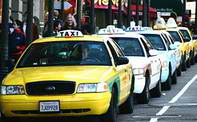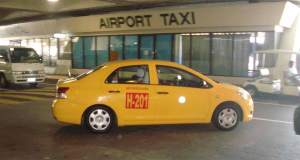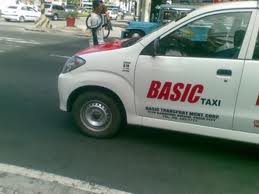I sometimes feel such a fraud as here I am, an Englishman, with a 20-word Tagalog vocabulary and I’m telling you about Manila and the Philippines. Yes, hands up, I should stand aside and let a real expert in to take over this blog.
Well, I will even go as far as to confess that much of the time I’ve been here over the last 7 years have been spent lying on my fat arse making me even more unfit to report. So all I’m offering really is an account of how it’s been for me. So maybe it’s time to start putting you in touch with some more authoritative people and give you a few links so you can explore for yourself.
Probably the best known tourist guide as well as social activist for want of a better term is Carlos Celdran. I hadn’t been here all that long when I saw a program on the Living Asia channel.
The program in question featured Carlos on a tour of Chinatown. It may have featured more as I joined the program late, but what I watched had me spellbound. Not only does he give you incredible information, the guy is pure entertainment. I plan to go on one of his tours myself. I have no idea why I haven’t done so already; just one of those things.
Carlos is fully aware of the contradictions in Filipino culture and graphically highlights much of this by pointing out the mixing of Chinese, Catholic and native tradition and tells it how it is. I can honestly say it was a mesmerizing watch. I’m certain that going on one of his tours would be all the more entertaining than simply watching him on TV. On his website, he also lists other guides that you can consider but I think Carlos is terrific value for money and you will return back to your accommodation knowing a lot more and have a far better understanding of Manila life, its people and culture.
Ordinary Living
I’ve eaten here and there; loved it, hated it, and it’s been okay sometimes, but to tell you the names of the places I would have to run back over old ground. I’m in the process of doing that and that’s another article for another day. Personally, I am not a TGI Fridays type. Nothing wrong with it and it’s very much used by expats and visitors alike and the food is yummy, but it’s out of my price range.
I personally tend to eat out of local eateries which are just about everywhere. You’re never far from food wherever you go in Metro Manila. It’s not what many who are here for a brief stay would probably be interested in but it’s very much a piece of real Filipino life. The nice restaurant or should I say more up market places are out of the range for most ordinary Filipinos sadly. There are many who can afford it and I tend to find if the food was cheaper, then the beer was very expensive. Sometimes it’s the other way round. When I say expensive, even the more up market prices are a lot less than what we pay in our home countries.
Eateries are simply where everyday Filipinos eat maybe in their lunch break. Some eat exclusively at such places as they may be residing in a dormitory which possibly lacks cooking facilities. Many working locals not only do an 8-hour day or often more; they also have a 2-hour commute to and from work taking an additional 4 hours every day out of their lives. Food in eateries is cheap therefore a natural lure for the overworked underpaid populace of Metro Manila.
I’ve got drunk in local videoke bars, tramped around every mall and touched on many areas. But on most occasions, I simply chose places randomly for better or worse.
It definitely has its moments, if you spend all your time in the hotel bar or eat in quality restaurants; the only locals you will experience will be the waiter.
Virtually anywhere in Metro Manila, you are never far from a mall. Some are large, some small, some old and some new, but none are as huge as the SM Mall of Asia in Pasay City, Metro Manila. MOA is the biggest and not only good for shopping, but eating, drinking, cinemas, a convention center also an amusement park, events venue with over 10,000 capacity, and it even has an ice rink.
Malls are everywhere. They can be quieter on weekdays between paycheques especially, and teeming at weekends, especially the weekend after payday.
Some have indoor market areas selling mostly clothes and general haberdashery, mobile phones, laptops and tablets generic or otherwise. Outdoor stalls are never too far away from any mall as retailers hope to take advantage of the passing crowds selling everything from street food to jackets and DVD’s (pirated, of course).
Some malls are up market and some old and decrepit. I find some of the older ones as enjoyable as the modern ones having less emphasis on the usual brands, and where you can find ukay-ukay stores among school supplies, DVDs, musical instruments and pretty much everything. If you’re as Kuripot (tight-fisted) as me, then the overruns and sometimes second-hand stock in ukay-ukay stores are a great way to find something different at often incredibly cheap prices. If you’re not too snobbish and think wider than branded clothes, you can find items for as low as 50 pesos and even less sometimes.
 Markets are everywhere too and also very much a feature of everyday life for Filipinos. The main wholesale area is Divisoria in Chinatown where you will find cheap imports as well as fruit, veg, wet and dry goods, and just about anything else from electrical to paper and curtains at possibly the cheapest prices in the whole of the Capital. In fact, pretty much everything is at Divisoria, the most significant market in all of Metro Manila. It is not just a market in the traditional sense, as it has stalls alongside stores in a variety of malls from old to new. The more traditional outdoor market is worth braving the excessive crowding for, and after spending a few hours at Divisoria, there is no shortage of interesting places to eat.
Markets are everywhere too and also very much a feature of everyday life for Filipinos. The main wholesale area is Divisoria in Chinatown where you will find cheap imports as well as fruit, veg, wet and dry goods, and just about anything else from electrical to paper and curtains at possibly the cheapest prices in the whole of the Capital. In fact, pretty much everything is at Divisoria, the most significant market in all of Metro Manila. It is not just a market in the traditional sense, as it has stalls alongside stores in a variety of malls from old to new. The more traditional outdoor market is worth braving the excessive crowding for, and after spending a few hours at Divisoria, there is no shortage of interesting places to eat.
However, a word of advice. Only yesterday I wasn’t cautious and fell prey to a very talented thief. I had a backpack thrown over one shoulder. I felt a mild movement from my bag, barely noticeable. I thought at first someone passing by behind had lightly brushed past and thought that was what I had felt. I turned around and only saw the usual crowds walking by, nothing unusual but noticed a front zip was open. Straight away I knew what had happened and I had a cellphone in there. Before I checked, I knew it was gone. I had been warned to be careful when in Divisoria as pickpockets and snatchers take advantage of the crowds. Best advice is if you have a back pack, wear it on your chest where you can see it. Don’t keep a wallet or phone in a trouser pocket. These thieves are damned good, be very careful.
Other prominent markets in Metro Manila include Farmers market in Cubao, Quezon City, Blumentritt, Manila, Commonwealth again in Quezon City.
Beyond these markets are 100s of smaller neighbourhood markets and unofficial ones that seem to spring up along every highway, unused corner or bridge.
Many here kill time in Malls even those without money. I’ve seen crowds of 20 watching the pictures on the display TVs in shop windows just to pass time. Malls are far more than shopping. They are where everybody meets, dates and enjoys the free air-con. Some come to use the chapel and some even come to shop, you may be surprised to know.
Market (Palengke) is a little more hard-core jostling with crowds, carts and tricycles and definitely more tiring, but still a great way to see some real life here whilst grabbing bargains and pigging out all at the same time.
Naturally enough you’re going to hear “Hey Joe” 30 times over and some traders may raise the price when you enquire, but mostly they don’t, and the same in stores.
As much a day for watching than spending and a great view into people’s lives here, should you want to see. But there again, you could sit in TGI Fridays but it’s your choice.

 Allow me to begin on a serious note. Criticisms have not been much really and I could possibly be accused of making too much of it. But after having posts deleted from a group and comments from people (never directly to me) with some complaining my posts have a negative tone and requesting my posts not be allowed into certain groups, well this is my simple answer to you.
Allow me to begin on a serious note. Criticisms have not been much really and I could possibly be accused of making too much of it. But after having posts deleted from a group and comments from people (never directly to me) with some complaining my posts have a negative tone and requesting my posts not be allowed into certain groups, well this is my simple answer to you. 
 I have often thought what a difficult job it must be to be a comedian in the Philippines as they have a particularly amusing habit of having to announce a joke. When you’ve asked questions and got to the bottom of it, it’s again just one of those things which is easily explained and many of the assumptions as to why this is are not what they seem. Allow me to be a little clearer.
I have often thought what a difficult job it must be to be a comedian in the Philippines as they have a particularly amusing habit of having to announce a joke. When you’ve asked questions and got to the bottom of it, it’s again just one of those things which is easily explained and many of the assumptions as to why this is are not what they seem. Allow me to be a little clearer.


 One of the most unpleasant aspects of being here is the many locals wanting to aid you in finding what they perceive you are looking for. “Chicks, sir” is often called out to you. You ignore them yet they are so confident you’re a deviant foreigner, they actually follow you and keep up the asking of what it is you want, and simply don’t take no for an answer.
One of the most unpleasant aspects of being here is the many locals wanting to aid you in finding what they perceive you are looking for. “Chicks, sir” is often called out to you. You ignore them yet they are so confident you’re a deviant foreigner, they actually follow you and keep up the asking of what it is you want, and simply don’t take no for an answer. The most convenient method of travel around Metro Manila is by taxi. They are cheap and there are certainly plenty of them. Let it also be said that most are usually quite decent and fair and do as they should by putting the meter on before they drive off with you on board. They also take you to your destination via the shortest route, are polite and I cannot say enough good to credit these guys.
The most convenient method of travel around Metro Manila is by taxi. They are cheap and there are certainly plenty of them. Let it also be said that most are usually quite decent and fair and do as they should by putting the meter on before they drive off with you on board. They also take you to your destination via the shortest route, are polite and I cannot say enough good to credit these guys. I stand by my comments regarding most taxi drivers being not so bad and we should not forget that. But again, we are in territory where certain things have to be said. Some Metro Manila taxi drivers are totally beyond the limit. It also seems that little is being done about it.
I stand by my comments regarding most taxi drivers being not so bad and we should not forget that. But again, we are in territory where certain things have to be said. Some Metro Manila taxi drivers are totally beyond the limit. It also seems that little is being done about it.  On a bad day, you may encounter 3 or 4 of these before you find one that actually is aware that he is a taxi driver and they are supposed to drive wherever you want to go. They operate as if it is for their convenience and not yours. Take a deep breath and just let him go.
On a bad day, you may encounter 3 or 4 of these before you find one that actually is aware that he is a taxi driver and they are supposed to drive wherever you want to go. They operate as if it is for their convenience and not yours. Take a deep breath and just let him go. On rare occasions, you may find yourself subjected to a little magic. This is the name given to a little device that some taxis have which manually moves the meter by clicking a little handheld button. This is something they are more likely to use on a foreigner in the belief you are not aware of the rate that the meter clicks up a few pesos. Every time they click the button, the meter increases.
On rare occasions, you may find yourself subjected to a little magic. This is the name given to a little device that some taxis have which manually moves the meter by clicking a little handheld button. This is something they are more likely to use on a foreigner in the belief you are not aware of the rate that the meter clicks up a few pesos. Every time they click the button, the meter increases.
 To give you a fuller picture of what I’m talking about, I will give an account of how it used to be.
To give you a fuller picture of what I’m talking about, I will give an account of how it used to be.  The rules and changes are in their infancy still, but at last they know they had to do something. The MRT took the lead and a little later, the LRT was playing their part, too, although it would appear that although the MRT line began the initiative, they haven’t quite managed the implementation as well as the LRT. The first thing the MRT did was to paint a yellow box positioned where each door of the train stops. Not long after, the LRT did the same. The idea being that people are supposed to not enter the yellow box until those wanting to exit the train was all off. In short, it’s being much better implemented by the LRT lines; MRT improvements in enforcing discipline seems to be not working too well, but let’s hope that is addressed soon.
The rules and changes are in their infancy still, but at last they know they had to do something. The MRT took the lead and a little later, the LRT was playing their part, too, although it would appear that although the MRT line began the initiative, they haven’t quite managed the implementation as well as the LRT. The first thing the MRT did was to paint a yellow box positioned where each door of the train stops. Not long after, the LRT did the same. The idea being that people are supposed to not enter the yellow box until those wanting to exit the train was all off. In short, it’s being much better implemented by the LRT lines; MRT improvements in enforcing discipline seems to be not working too well, but let’s hope that is addressed soon.